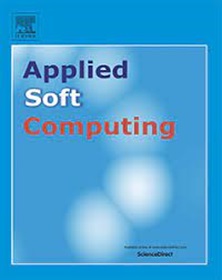An effective surrogate-assisted rank method for evolutionary neural architecture search
IF 7.2
1区 计算机科学
Q1 COMPUTER SCIENCE, ARTIFICIAL INTELLIGENCE
引用次数: 0
Abstract
Evolutionary neural architecture search (ENAS) is able to automatically design high-performed architectures of deep neural networks (DNNs) for specific tasks. In recent years, surrogate models have gained significant traction because they can estimate the performance of neural architectures, avoiding excessive computational costs for training. However, most existing surrogate models primarily predict the performance of architectures directly or predict pairwise comparison relationships, which makes it challenging to obtain the rank of a group of architectures when training samples are limited. To address this problem, we propose TCMR-ENAS, an effective triple-competition model-assisted rank method for ENAS. TCMR-ENAS employs a novel triple-competition surrogate model combined with a score-based fitness evaluation method to predict group performance rank. Moreover, a progressive online learning method is proposed to enhance the predictive performance of the triple-competition surrogate model in the framework of modified genetic search. To validate the effectiveness of TCMR-ENAS, we conducted a series of experiments on NAS-Bench-101, NAS-Bench-201, NATS-Bench and NAS-Bench-301, respectively. Experimental results show that TCMR-ENAS can achieve better performance with lower computational resources. The accuracies of searched architectures achieve the best results compared with those of the state-of-the-art methods with limited training samples. In addition, the factors that may influence the effectiveness of TCMR-ENAS are explored in the ablation studies.
进化神经架构搜索的有效代用辅助秩方法
进化神经架构搜索(ENAS)能够为特定任务自动设计高性能的深度神经网络(DNN)架构。近年来,由于代用模型可以估算神经架构的性能,避免了过高的训练计算成本,因此受到了广泛关注。然而,大多数现有的代用模型主要是直接预测架构的性能或预测成对比较关系,这使得在训练样本有限的情况下,获得一组架构的等级具有挑战性。为了解决这个问题,我们提出了 TCMR-ENAS,一种有效的三重竞争模型辅助 ENAS 排名方法。TCMR-ENAS 采用了一种新颖的三重竞争代用模型,结合基于分数的适配性评估方法来预测组性能排名。此外,还提出了一种渐进式在线学习方法,以在修正遗传搜索框架内提高三重竞争代用模型的预测性能。为了验证 TCMR-ENAS 的有效性,我们分别在 NAS-Bench-101、NAS-Bench-201、NATS-Bench 和 NAS-Bench-301 上进行了一系列实验。实验结果表明,TCMR-ENAS 能以较低的计算资源获得更好的性能。在训练样本有限的情况下,与最先进的方法相比,所搜索架构的准确度达到了最佳效果。此外,在消融研究中还探讨了可能影响 TCMR-ENAS 效果的因素。
本文章由计算机程序翻译,如有差异,请以英文原文为准。
求助全文
约1分钟内获得全文
求助全文
来源期刊

Applied Soft Computing
工程技术-计算机:跨学科应用
CiteScore
15.80
自引率
6.90%
发文量
874
审稿时长
10.9 months
期刊介绍:
Applied Soft Computing is an international journal promoting an integrated view of soft computing to solve real life problems.The focus is to publish the highest quality research in application and convergence of the areas of Fuzzy Logic, Neural Networks, Evolutionary Computing, Rough Sets and other similar techniques to address real world complexities.
Applied Soft Computing is a rolling publication: articles are published as soon as the editor-in-chief has accepted them. Therefore, the web site will continuously be updated with new articles and the publication time will be short.
 求助内容:
求助内容: 应助结果提醒方式:
应助结果提醒方式:


